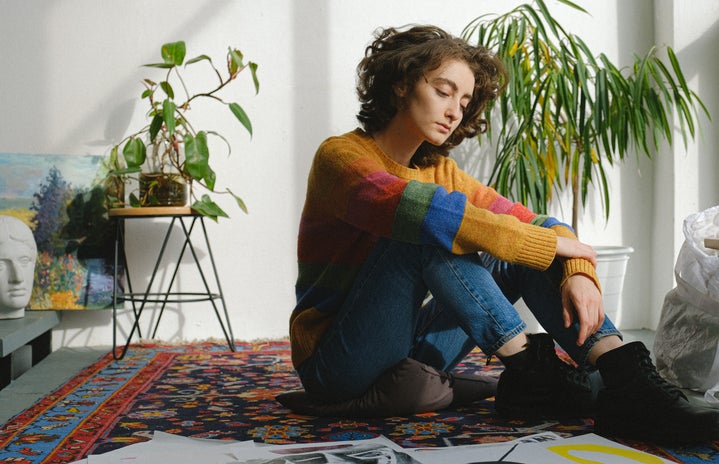I know you probably clicked on this article because of the title, but the truth is, I don’t know. I don’t know how to stay happy myself, so I am definitely not a reliable authority on the distribution of such advice. I wake up every day to the same alarm. I sit down in the shower and let the water and steam fill me. I cry when certain movies play, or when my clothes or other people touch me just wrong enough. And I know that that fact might frustrate you. Mia, you used a clickbait title. What were you expecting? But I still thought it could be important to write on, so here we are. In the trenches, together.
I wish I had answers for both of us, but the truth of the matter is that college often breeds this sadness, an all-encompassing depression that drills into every part of you. In an article written by Mayo Clinic, they stated that “a recent study found … 1 in 3 college students experiences significant depression and anxiety” in 2022. Of course, with these heightened numbers, it is important to consider the impacts of the COVID-19 pandemic and lockdown on youth, but I still theorize that a large part of the problem we’re all facing comes from the way college itself is structured.
Since middle school, I was told that I needed to figure out who and what I was going to be. Even before that, in the 6th grade, they used to make us write our desired careers on a handheld chalkboard and pose with it for the yearbook (there were so many astronauts and scientists; I just wanted to be a writer). We did research projects about our projected salaries, and the educational paths we needed to take (that often stretched into doctoral programs). Mind you, we were 12 years old.
But all that stress and anxiety, built up by the academic system, has officially culminated in where you are now. The dorm you sleep in. The lecture halls you’re late to. You are the version of yourself that 12-year-old imagined way back in middle school. It’s kind of stressful when you take a step back and consider who you were, and how you got here.
That isn’t even discussing the structure of college itself. As an honors student at ASU, I was doused in information about intern programs and MA coursework from the moment I walked in. This isn’t to say that I don’t appreciate the resources I have and the opportunities afforded to me that allowed me to get this far; they are my proudest accomplishment.
Still, it is a high-stress environment from the get-go and a socially-isolating one at that. A report by Sodexo revealed that “more than half (53%) of current college students say that they’re lonely”. Making new friends, outside of those two or three from high school that you talked to every day, is hard. You worry about being amicable enough or smooth the creases in your jeans when you talk. You present yourself like a product on display, hoping that your ribbon and lace are any different from the thousands of people next to you, doing the same exact thing. It’s hard.
Beyond the basic reasons we all know for depression on campus, (i.e, the repetitive nature of classes, the friendliness, being homesick, etc.), college is the breeding ground for some pretty vile things. In statistical terms, “9.7% of females and 2.5% of males experience rape or sexual assault through physical force, violence, or incapacitation” and “26.4% of females and 6.8% of males experience rape or sexual assault through physical force, violence, or incapacitation.”
This, of course, is not accounting for the myriad of sexual assaults that go unreported. Beyond this, when students do report their experiences and seek campus help, it often results in stagnancy or a lack of response, as we have observed at ASU with the case of Alayna. For more specific information on her case and the heartbreaking reality for lots of sexual assault survivors, read this piece by ASU’s student newspaper, The State Press. Victims of sexual assault often spiral into a long-term depressive state, and there is a definite correlation between sexual violence on college campuses in recent years and the rising depression rates.
In a similar sense, drug and alcohol use increases when kids attend college. Even at ASU (shocker, I know) where President Crow has strived to make the change toward a dry campus, there is more than ample evidence to prove the very opposite – that students here drink and smoke recreationally. This nation is plagued with addiction, and introducing substances to a contained, young population can have detrimental effects on mental health.
Beyond all this, sometimes depression is just that: depression. There is no cause or motivation behind those feelings. It’s all just brain chemistry. It exceeds the borders of your control, even though that’s all you want. To be able to wake up and not have to worry about people knowing your smile is fake.
We can sit around all day and say there are perfect solutions, but that would be a lie. Medication doesn’t work the same for everyone. Some people can’t forget their problems through meditation. The point of this article was not to be so pessimistic, but this is the reality many of us live in. At the end of the day, we can be kind. I don’t write this to seem like some 40-year-old Scottsdale mom, but you really do never know what someone else is going through. For now, that’s all there really is. So let’s agree to be kind and know that someday it will all be easier.


